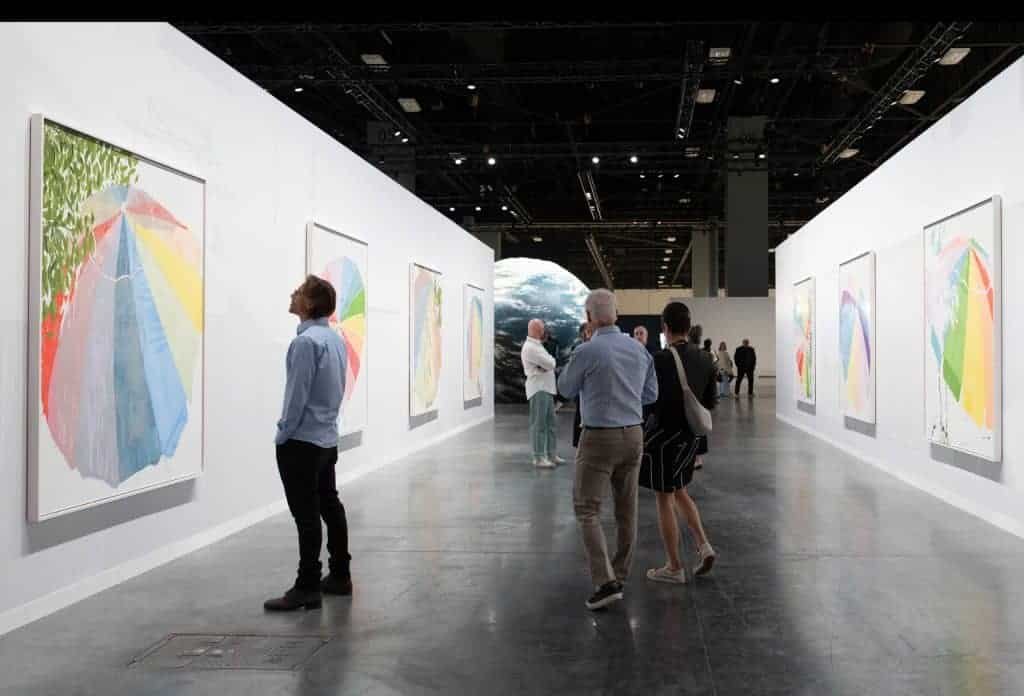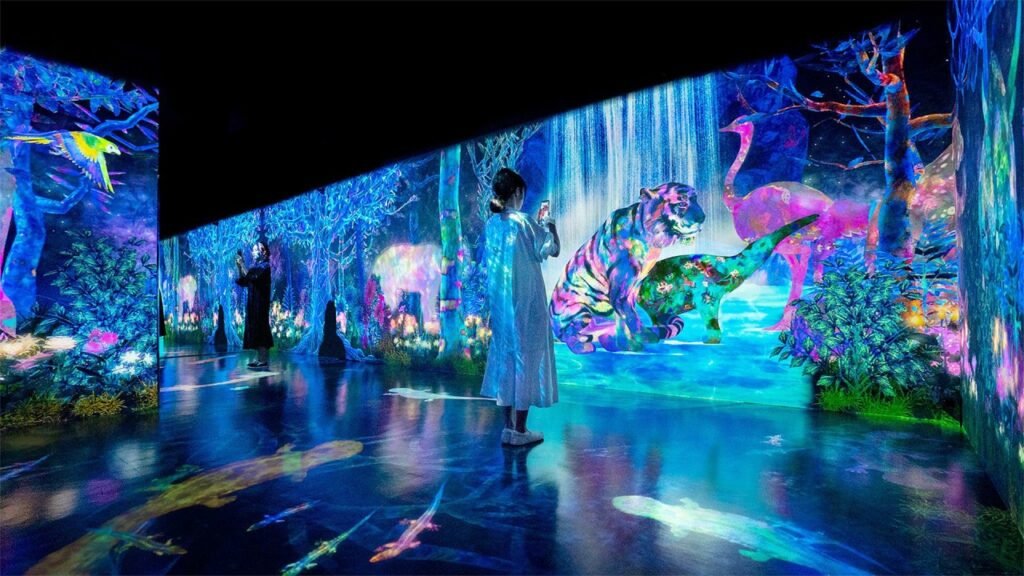Art installations have evolved dramatically over the years, becoming a key element in contemporary art exhibitions. From large-scale immersive experiences to thought-provoking environmental works, the installation art scene is continually innovating. As we look toward the future, several exciting trends are emerging that will define upcoming exhibitions. These trends focus on interactivity, technology, environmental awareness, and the power of personal experiences. Let’s explore the trends you should watch in the world of art installations.
1. Immersive Art Installations: Fully Engaging the Senses
Immersive art has become one of the most exciting trends in recent years, and it’s showing no signs of slowing down. These installations completely engage visitors, transforming the gallery space into an experience rather than just a place to view art. Using a combination of visual, auditory, and even tactile elements, immersive installations create environments that allow visitors to step into the artist’s vision.
One of the most iconic examples of immersive art is the work of Yayoi Kusama, whose “Infinity Rooms” envelop viewers in mirrors and bright lights, creating an illusion of endless space. Similarly, teamLab, a collective of artists and technologists, creates interactive, digital installations where light, sound, and motion react to visitors’ movements.
In upcoming exhibitions, expect more installations that transport you into dreamlike or surreal worlds, blending art, technology, and the physical space in ways that push the boundaries of what art can be.
2. Interactive Installations: Audience Participation as Art
Another exciting trend is the rise of interactive installations that encourage audience participation. These works invite viewers to physically engage with the artwork, becoming part of the creative process and altering the piece in real time. This shift challenges the traditional artist-viewer relationship, turning passive observers into active participants.
Interactive art often employs technology such as motion sensors, augmented reality (AR), or touch-sensitive surfaces. For example, artist Rafael Lozano-Hemmer’s “Pulse Room” invites visitors to step inside a room where lightbulbs pulse in time with their heartbeats, creating a deeply personal experience for each viewer.
Future exhibitions will likely continue to explore the intersection of art and technology, offering new ways for audiences to shape their artistic experience. These installations create an intimate connection between the art and its audience, making the viewer’s role a crucial part of the art’s meaning.
3. Environmental and Eco-Conscious Installations
As the world becomes more aware of environmental issues, art installations are increasingly reflecting these concerns. Environmental art installations aim to raise awareness about climate change, sustainability, and our relationship with nature. These works can range from sculptures made from recycled materials to large-scale outdoor installations that integrate natural landscapes.
In upcoming exhibitions, artists are likely to continue creating pieces that engage directly with the environment. For example, installations that use organic materials like plants, water, and earth will allow viewers to reflect on their impact on the planet. Works that engage with nature—whether through the use of natural light, sound, or organic materials—are becoming more prevalent as artists explore themes of preservation and ecological balance.
Some artists have even turned entire exhibition spaces into immersive environments that mimic natural ecosystems or question our relationship with the Earth. These installations can serve as powerful commentary on humanity’s role in protecting the environment and the urgent need for climate action.

4. Digital and Virtual Reality Art Installations
Technology continues to play a significant role in shaping contemporary art, and digital and virtual reality (VR) installations are at the forefront of this revolution. Using cutting-edge technology, artists are creating virtual worlds, 3D environments, and even interactive avatars that allow visitors to experience art in ways never before possible.
Artists like James Turrell, who uses light and space to alter the viewer’s perception of reality, have paved the way for artists experimenting with VR and digital technologies. In VR-based exhibitions, visitors can immerse themselves in a completely digital world, experiencing art that exists only within the confines of the virtual space.
This trend also extends to augmented reality (AR), where physical spaces are transformed by digital layers that can only be seen through a smartphone or tablet. These digital enhancements allow the viewer to experience art in new, unexpected ways, enhancing their connection to the work.
Expect to see more art installations using VR, AR, and digital interfaces to create entirely new modes of experiencing art. These installations are not just visual but can incorporate sound, interactivity, and spatial elements that blur the line between reality and imagination.
5. Art as Social Commentary: Addressing Political and Social Issues
Art installations have always been a platform for social commentary, and this trend is intensifying in the current political climate. In the coming years, many installations will likely address themes such as gender equality, racial justice, migration, and the rights of marginalized communities.
Artists like Kara Walker and Ai Weiwei have made powerful statements through their installations, addressing themes of race, politics, and human rights. These installations often serve as a form of activism, urging viewers to reflect on societal issues and take action. As the world faces increasing challenges related to inequality, many contemporary artists will likely use their installations to create powerful social statements.
This trend will continue to grow as artists use installation art as a means to influence public opinion, inspire action, and foster dialogue. With the potential to reach large audiences, art installations are becoming an essential tool for social change.
6. Sensory Art Installations: Engaging More Than Just Sight
Sensory art installations go beyond visual experiences to engage multiple senses, such as sound, touch, and even smell. These works aim to create a fully immersive experience that stimulates the viewer’s entire sensory perception, often evoking deep emotional responses.
For example, artists might use sound installations to create an atmosphere of soundscapes that reflect natural environments or urban noise. Touch-based installations invite viewers to physically engage with the artwork, creating a more personal connection. Some installations even incorporate scents to evoke memories or feelings that are tied to specific places or experiences.
The goal of sensory installations is to create a holistic experience where art is felt as much as it is seen. In upcoming exhibitions, expect to see more installations that focus on the full sensory experience, creating moments of profound connection and introspection.
7. Augmented Spaces: Transforming the Gallery Environment
Augmented spaces take the concept of installation art beyond the physical medium and into the gallery itself. This trend involves transforming entire spaces with art that alters or redefines the boundaries of the exhibition area. This could mean integrating projections that extend beyond the walls, changing the ceiling and floor, or creating optical illusions that make the space feel fluid or interactive.
Artists are exploring the relationship between art and space, with installations that challenge the traditional gallery format. These augmented spaces turn the gallery into an active, dynamic environment that evolves with the viewer’s movement.
This trend has the potential to make the gallery itself feel like part of the artwork, enhancing the viewer’s experience and transforming the way we interact with art in public spaces.
Conclusion
The world of art installations is evolving rapidly, with emerging trends that embrace technology, interactivity, and social engagement. From immersive environments to eco-conscious statements, the future of art exhibitions is exciting and full of new possibilities. As art continues to push boundaries, these trends will shape how we experience and relate to the world around us. Whether you’re an artist or an art lover, keeping an eye on these trends will offer a deeper understanding of where the world of installation art is headed in the coming years.

